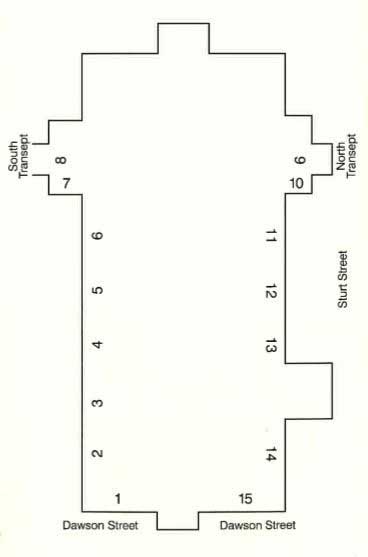ST PATRICK’S CATHEDRAL
BALLARAT, VICTORIA CATHOLIC
PAUL SCOTT

I found this very simple plan of the Cathedral which numbers the stained glass windows. The sanctuary is at the top, the West door at the bottom. Sturt Street is the main two-lane highway into Ballarat from the west.
A brief history of the Cathedral is given below. However, if you want to begin your tour of the Cathedral immediately, tap / click on START . You can also access intermediate points in the tour by a tap / click on the following links:
NOTE ON MAGNIFYING IMAGES
With this website format the images are large enough for most purposes. If there is a need for greater magnification of an image, go to the identical photo on
https://www.flickr.com/photos/paulscottinfo/albums
and use Command - + (Mac) or Windows - + (Windows).
HISTORY
St Patrick’s Cathedral, Ballarat
Although Catholic Services were conducted in Ballarat from 1851 onwards, the parish of Ballarat was not instituted until 1852. The first Parish Priest was Father Matthew Downing, who in 1853, selected the two acre site for the church, which was granted under a Crown Grant in 1855. The style of the church is early Gothic from the era of Edward the 1st in the 13th Century. The dimensions are basically 150ft by l00ft. On February 7th, 1858, Bishop James Alipius Goold laid the foundation stone for the church, which commenced being used on a regular basis for Mass in 1863. The miners presented the Bishop with gold nuggets which were formed into a Chalice and Paten, found today in the Victoria and Albert Museum, London. With this exception all the presentation plate is still held by the Diocese.
St Patrick’s was Ballarat’s only parish church from 1863 to 1963.The official opening of the church was in 1871 and when the Diocese of Ballarat was formed in 1874, the first Bishop, Dr Michael O’Connor chose it for his Cathedral.
When St Patrick’s Cathedral, Ballarat was finally consecrated in 1891 by Cardinal Moran of Sydney, it was the first Catholic Cathedral consecrated in the Australian Colonies, making it today Australia’s oldest consecrated Cathedral.
In 1887, a High Altar, which can be seen still today, and Stations of the Cross were purchased from Rome. The altar is of Carrara marble inlaid with precious stones including Antico Rossi, Lapis Lazuli and antique marbles. The tiles of the Sanctuary and side chapels are from Austria and those in the nave from Minton’s England. The first organ installed in 1867, was replaced with the Fincham in 1930.
The stained glass windows were introduced in 1883, the first being that in the Sanctuary. Following this were the Lady Chapel window and Blessed Sacrament Chapel window. These three windows were made in Germany and a slight variation in colour to the other windows can be noticed. The remaining windows were gradually added to, until the final one in 1910. Of these, the first was presented by the Loreto Sisters representing St Brigid (note her Crozier, the traditional mark of a Bishop). On the opposite side of the narthex is St Patrick’s window, donated by the third Bishop, Bishop Higgins (note the crozier piercing Aengus through the foot). Both these windows have the Holy Spirit uppermost. The side windows depict the parables.
An extensive renovation and liturgical upgrade of the Cathedral took place in 1999. Highlights of this were the installation of a new altar, tabernacle and baptismal space. Also of note was the discovery of the original paint colours around the sanctuary, which have been conserved in the renovation. The new altar, given by the Archdiocese of Melbourne, was consecrated by Cardinal George Pell on April 26, 2000.
Bishop Peter Connors retired as Bishop of Ballarat on 1 August 2012. Father Paul Bird CSsR was appointed by Pope Benedict XVI to be the diocese’s next bishop. His installation is expected to take place on 16 October 2012.
Five of Ballarat’s seven Bishops are buried in the crypt, which is in the northern transcept.
http://www.ballarat.catholic.org.au/aboutus/default.cfm?loadref=9



